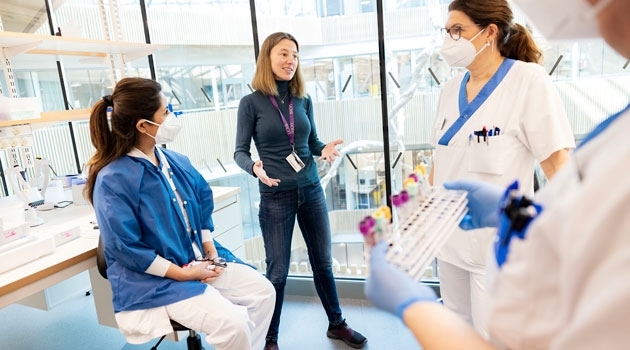Uppsala Biobank, a resource for healthcare
Uppsala Biobank proved itself to be an important resource early on and a route into healthcare for research. Today, Uppsala Biobank’s services are used by many clinical researchers at from Uppsala University and Uppsala University Hospital. But also by companies conducting clinical trials in the healthcare sector.
Uppsala Biobank began operating almost 13 years ago, but the history of the biobank starts much earlier. Anna Beskow, Head of Operations and Biobank Manager of Uppsala Biobank as well as Head of Section at the Uppsala Clinical Research Centre, tells us about the actual start of the biobank.
The Biobank Act, which regulates how samples may be collected, stored and used, was introduced in 2003. Before then, there were a number of sample collections in healthcare and research that were used without any clear control or follow-up.
Collaboration between the Region and the University
Manager of Uppsala Biobank and Head of Section
at the Uppsala Clinical Research Centre.
Photo: Mikael Wallerstedt
When Uppsala Biobank opened its doors on 1 September 2008, the aim was to establish a joint biobank organisation, and Anna Beskow was recruited as Head of Operations.
“We were intended to be a centre of excellence, handle the legal issues, and, in the long term, build up an operational service where we help researchers with sample collection, storage, and withdrawal of samples, and we manage information about the samples. And that is what Uppsala Biobank is today,” explains Anna Beskow.
It was a foregone conclusion that Uppsala Biobank would be a collaboration between the Region and the University, and this has also proven to be a recipe for success.
“There are many doctors who are also researchers. Depending on what research they are conducting, the research principal is sometimes Region Uppsala and sometimes Uppsala University. The aim was that they would not need to even think about this aspect, but simply get the help and support they need regardless,” explains Anna Beskow.
Long journey to the well-organised biobank
So how did they manage to make the journey from thousands of samples scattered across the region to the well-organised biobank that exists today?
“It was a long journey,” laughs Anna Beskow.
The task of transforming the 138 existing biobanks into sample collections in the joint biobank went to Research Coordinator Malin Engelmark. It was a task that took four years to complete.
“We were worried about how the researchers would handle the fact that we would take over the biobanking responsibility for the sample collections. Our attitude was that this would be a help to the researchers. We wanted to be clear that our mission was to help them comply with the law, and many researchers were grateful for that. They could sleep well at night and not have to worry about what it meant to be responsible for a biobank, while we gave them the reassurance that we would not take the samples away from them,” explains Anna Beskow.
Early on, the biobank also proved itself to be an important resource by both supporting compliance with the law and serving as a route into healthcare for research thanks to the joint organisation. Today, Uppsala Biobank’s services are used by not only many researchers from Uppsala University and Uppsala University Hospital. But also by companies conducting clinical trials in the healthcare sector.
Coordinates research on COVID-19
The fact that Uppsala Biobank is a functioning resource was demonstrated during the current pandemic. The biobanks were commissioned by the Swedish Research Council to coordinate research on COVID-19 nationally. With healthcare already on its knees, the already established healthcare-integrated biobanking was crucial for collecting samples for research on COVID-19. Research that is extremely important for handling the pandemic.
“Otherwise, problems are solved after they arise. But here, we had solved them beforehand. It was so nice to feel that we had really done something good, not only in Uppsala but in the whole of Sweden,” says Anna Beskow.
Petter Cronsten
Facts about Uppsala Biobank
Uppsala Biobank is a research infrastructure and a centre of excellence for biobanking issues at Uppsala University and Region Uppsala.
Number of employees: 26
Location: Hubben, Dag Hammarskjölds väg 38
What is a biobank: The law defines a biobank as a collection of samples. In Sweden, biobankings has been organised to provide legal issues, service and counselling.
Number of assignments per year: Hundreds if you count new collection clients, storage clients, selection, sample handling, consulting, biobank applications... (Almost impossible to answer!)

